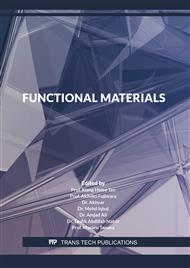[1]
Sloan E D, Koh C A. Clathrate Hydrates of Natural Gases, Third Edition [M]. Clathrate Hydrates of Natural Gas, (2008).
DOI: 10.1201/9781420008494
Google Scholar
[2]
Bavoh C B, Lal B, Osei H, Sabil K M, Mukhtar H J J O N G S, Engineering. A Review on the Role of Amino Acids in Gas Hydrate Inhibition, CO2 Capture and Sequestration, and Natural Gas Storage [J] Journal of Natural Gas Science & Engineering. 2019, 64: 52-71.
DOI: 10.1016/j.jngse.2019.01.020
Google Scholar
[3]
Takeya S, Muromachi S, Yamamoto Y, Umeda H, Matsuo S. Preservation of CO2 hydrate under different atmospheric conditions [J]. Fluid Phase Equilibria, 2016, 413: 137-141.
DOI: 10.1016/j.fluid.2015.10.036
Google Scholar
[4]
Thoutam P, Rezaei Gomari S, Chapoy A, Ahmad F, Islam M. Study on CO2 Hydrate Formation Kinetics in Saline Water in the Presence of Low Concentrations of CH4 [J]. ACS Omega, 2019, 4: 18210-18218.
DOI: 10.1021/acsomega.9b02157
Google Scholar
[5]
Liu Y, Wang P, Yang M, Zhao Y, Zhao J, Song Y. CO2 sequestration in depleted methane hydrate sandy reservoirs [J]. Journal of Natural Gas Science and Engineering, 2018, 49:428-434.
DOI: 10.1016/j.jngse.2017.10.023
Google Scholar
[6]
Hassanpouryouzband A, Yang J, Tohidi B, Chuvilin E, Istomin V, Bukhanov B. Geological CO2 Capture and Storage with Flue Gas Hydrate Formation in Frozen and Unfrozen Sediments: Method Development, Real Time-Scale Kinetic Characteristics, Efficiency, and Clathrate Structural Transition [J]. ACS Sustainable Chemistry & Engineering, 2019, 7: 5338-5345.
DOI: 10.1021/acssuschemeng.8b06374
Google Scholar
[7]
Cheng Z, Li S, Liu Y, Zhang Y, Ling Z, Yang M, Jiang L, Song Y. Post-combustion CO2 capture and separation in flue gas based on hydrate technology:A review[J]. Renewable and Sustainable Energy Reviews, 2022, 154: 111806.
DOI: 10.1016/j.rser.2021.111806
Google Scholar
[8]
Komatsu H, Ota M, Smith R L, Inomata H. Review of CO2–CH4 clathrate hydrate replacement reaction laboratory studies – Properties and kinetics [J]. Journal of the Taiwan Institute of Chemical Engineers, 2013, 44: 517-537.
DOI: 10.1016/j.jtice.2013.03.010
Google Scholar
[9]
Matsui H, Jia J, Tsuji T, Masuda Y. Microsecond simulation study on the replacement of methane in methane hydrate by carbon dioxide, nitrogen, and carbon dioxide-nitrogen mixtures [J]. Fuel, 2020, 263:116640.
DOI: 10.1016/j.fuel.2019.116640
Google Scholar
[10]
Long Z, Zha L, Liang D, Li D. Phase Equilibria of CO2 Hydrate in CaCl2–MgCl2 Aqueous Solutions [J]. Journal of Chemical & Engineering Data, 2014, 59: 2630-2633.
DOI: 10.1021/je500400s
Google Scholar
[11]
Gambelli A M, Tinivella U, Giovannetti R, Castellani B, Giustiniani M, Rossi A, Zannotti M, Rossi F. Observation of the Main Natural Parameters Influencing the Formation of Gas Hydrates [J]. Energies, 2021, 14: 1803-1827.
DOI: 10.3390/en14071803
Google Scholar
[12]
Chou I M, Song Y, Burruss R C. A new method for synthesizing fluid inclusions in fused silica capillaries containing organic and inorganic material[J]. Geochimica et Cosmochimica Acta, 2008, 72 (21): 5217-5231.
DOI: 10.1016/j.gca.2008.07.030
Google Scholar
[13]
Sun J, Chou I M, Jiang L, Lin J, Sun R. Crystallization Behavior of the Hydrogen Sulfide Hydrate Formed in Microcapillaries [J]. ACS Omega, 2021, 14288-14297.
DOI: 10.1021/acsomega.1c01051
Google Scholar
[14]
Zhao J, Xu K, Song Y, Liu W, Lam W, Liu Y, Xue K, Zhu Y, Yu X, Li Q. A Review on Research on Replacement of CH4 in Natural Gas Hydrates by Use of CO2 [J]. Energies, 2012, 5: 399-419.
DOI: 10.3390/en5020399
Google Scholar
[15]
Xie Y, Zhu Y, Zheng T, Yuan Q, Sun C, Yang L, Chen G. Replacement in CH4-CO2 hydrate below freezing point based on abnormal self-preservation differences of CH4 hydrate [J]. Chemical Engineering Journal, 2020, 403: 126283.
DOI: 10.1016/j.cej.2020.126283
Google Scholar



